Italian Meatloaf
This Italian Meatloaf is a warm embrace of old-world flavors and modern comfort. Inspired by the rustic simplicity of Italian home cooking, it weaves together finely chopped vegetables, aromatic basil, sharp Parmigiano-Reggiano, and a rich blend of beef and pork. The tender loaf is gently baked under a blanket of marinara, creating a deeply savory centerpiece that’s both nostalgic and nourishing.
Unlike the traditional American version, this meatloaf leans into the heart of Italian cuisine—with fresh herbs, soffritto-style vegetables, and a breadcrumb-and-cheese base that keeps every bite moist and full of flavor. It’s the kind of dish that feels familiar yet elevated, perfect for Sunday dinners, family gatherings, or make-ahead freezer meals that don’t compromise on taste.
This isn’t just meatloaf—it’s a celebration of Italian comfort food done with care.
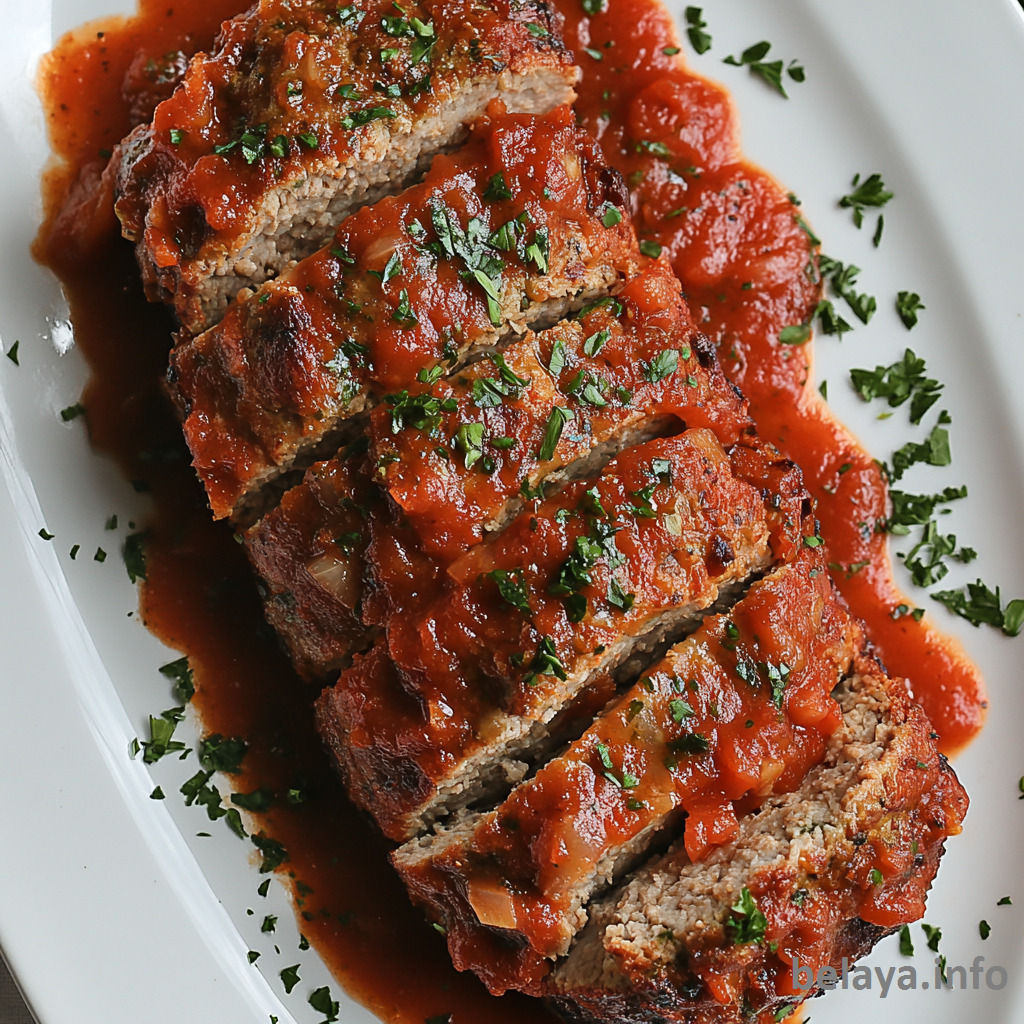
Why People Will Love This Italian Meatloaf:
Rich, Layered Flavors:
The combination of sautéed aromatics, fresh basil, aged Parmigiano-Reggiano, and marinara sauce creates a deeply savory, well-rounded taste in every bite.
Comfort Food with an Italian Twist:
It delivers the cozy, nostalgic feel of traditional meatloaf while infusing it with distinctly Italian ingredients and techniques.
Moist and Tender Texture:
The use of both ground beef and pork, along with eggs and breadcrumbs, keeps the meatloaf juicy and perfectly structured—not dry or crumbly.
Nutritious Hidden Veggies:
Finely chopped carrots, onions, celery, and garlic are cooked down and blended into the loaf—adding nutrition without overpowering the taste.
Family-Friendly and Freezer-Friendly:
This dish is ideal for feeding a crowd or freezing for future meals, making it a practical choice for busy families or meal preppers.
Beautifully Balanced:
A touch of Worcestershire adds umami depth, the basil brightens the dish, and the marinara sauce ties everything together with gentle acidity.
Homemade, Yet Effortless:
Though it tastes like something from an Italian grandmother’s kitchen, the steps are simple and easy to follow—even for beginners.
Versatile for Any Occasion:
Serve it on a weeknight or dress it up for guests. It pairs wonderfully with pasta, salad, roasted vegetables, or warm crusty bread.
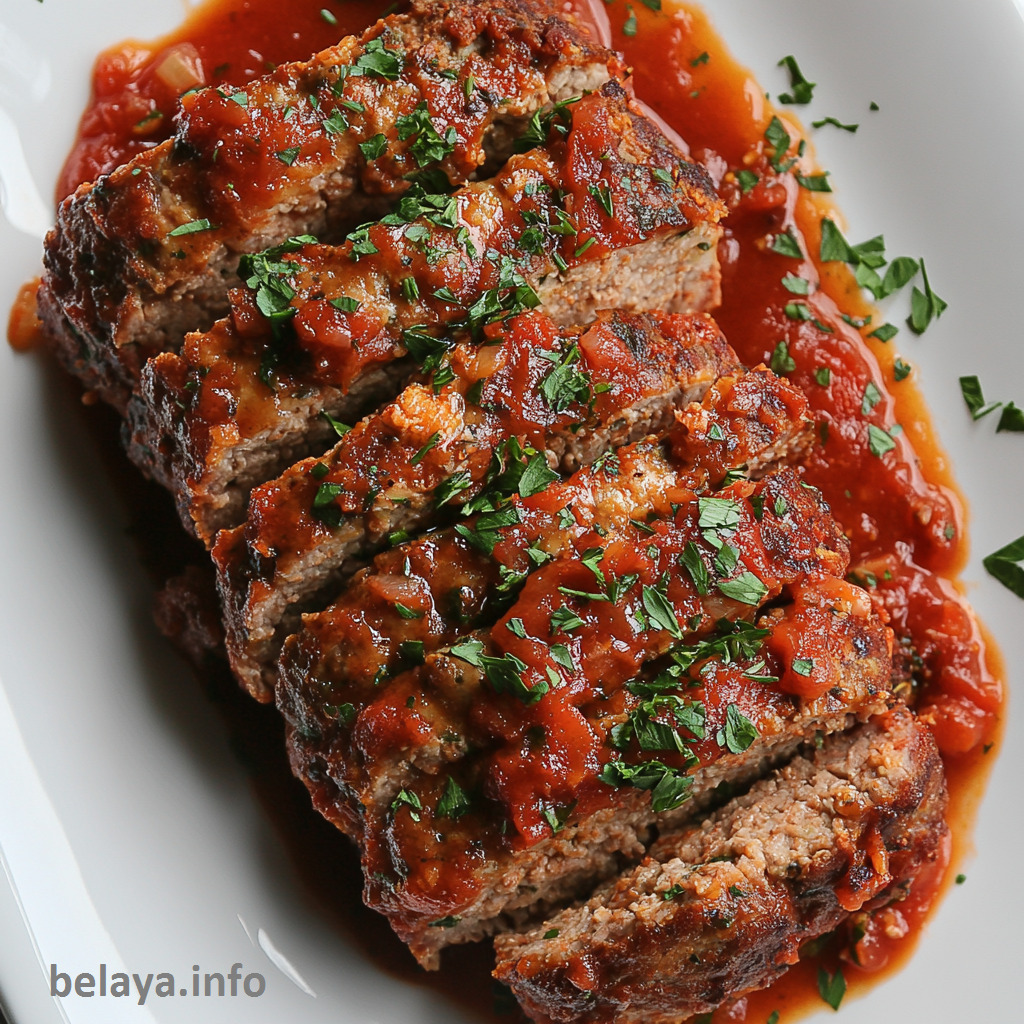
Key Ingredients:
Ground Beef and Pork:
The combination of beef and pork offers a balance of bold flavor and tender texture. Beef brings richness, while pork adds moisture and subtle sweetness that keeps the meatloaf juicy and satisfying.
Soffritto Base (Onion, Carrot, Celery, Garlic):
This classic Italian flavor foundation is gently sautéed to unlock its natural sweetness and depth, creating a savory backbone that elevates the entire dish.
Fresh Basil:
Bright and aromatic, basil adds a burst of freshness that cuts through the richness of the meat and cheese, bringing an unmistakable Italian essence.
Parmigiano-Reggiano:
Aged and deeply flavorful, this cheese infuses the loaf with a nutty sharpness and umami depth, acting as both a seasoning and a binding element.
Italian-Style Bread Crumbs:
These seasoned crumbs not only help hold the loaf together but also absorb juices and flavors, ensuring a cohesive texture in every bite.
Marinara Sauce:
Spoonfuls of marinara over the top infuse the meatloaf with tangy tomato richness while keeping the exterior moist and oven-glazed to perfection.
Worcestershire Sauce:
Just a tablespoon adds unexpected depth—umami, slight tang, and savory complexity that enhance the meat’s natural flavor without overpowering.
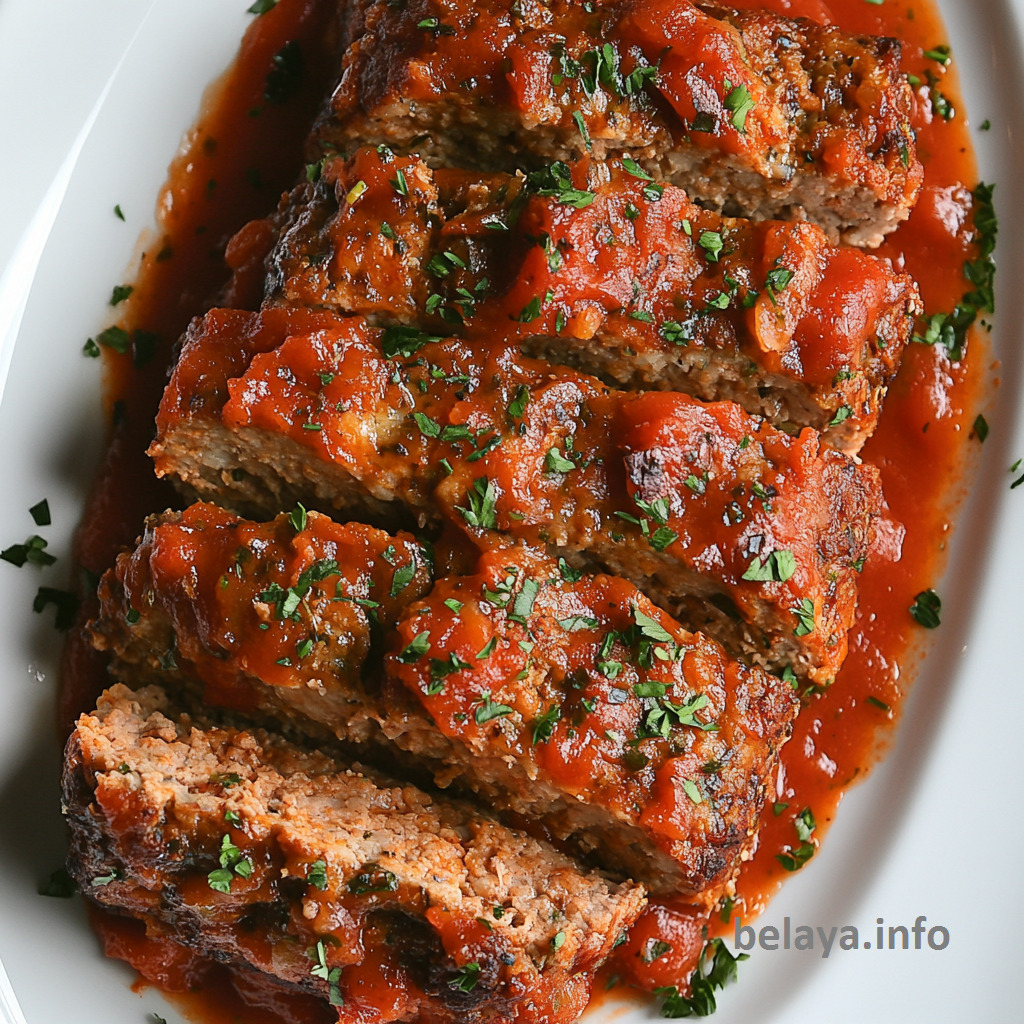
Expert Tips for the Best Italian Meatloaf
Sweat, Don’t Brown, the Vegetables:
When sautéing the onion, carrot, celery, and garlic, keep the heat at medium and avoid browning. Sweating the vegetables gently coaxes out their natural sweetness, creating a more refined flavor base without introducing bitterness.
Use Fresh Herbs Whenever Possible:
Fresh basil adds a brighter, more aromatic lift than dried herbs. If you’re growing it or can get it fresh, it makes a noticeable difference in the final flavor.
Grate the Cheese Fresh:
Use a fine grater for the Parmigiano-Reggiano. Pre-grated cheese often contains anti-caking agents that can affect texture and melting. Freshly grated cheese blends more smoothly into the meat mixture.
Mix Gently but Thoroughly:
Overworking the meat can make the loaf dense and tough. Use your hands to gently fold the ingredients together just until combined—think of it like folding cake batter.
Let the Cooked Veggies Cool First:
Mixing hot vegetables directly into the meat and eggs can partially cook the protein or scramble the eggs. Let the sautéed mixture cool to lukewarm to maintain proper texture and structure.
Rest Before Slicing:
After baking, allow the meatloaf to rest for at least 10 minutes. This helps the juices redistribute, keeping the slices moist and intact when cut.
Line and Spray the Pan:
Use foil and nonstick spray to make cleanup easier and prevent sticking. A flat baking sheet (instead of a loaf pan) allows better air circulation and helps the exterior develop a beautiful caramelized crust.
Double the Marinara for Serving:
While the meatloaf bakes with sauce on top, it really shines when served with extra warmed marinara on the side. It enhances the Italian character and keeps every bite luscious.
Use an Instant-Read Thermometer:
To avoid overbaking, rely on an instant-read thermometer. The perfect internal temperature is 160°F (71°C). Going much beyond that risks a dry loaf.
Make It Ahead and Chill the Mixture:
For deeper flavor and firmer texture, you can prep the meat mixture a few hours in advance or even overnight. Resting it in the fridge lets the seasonings meld and makes shaping easier.
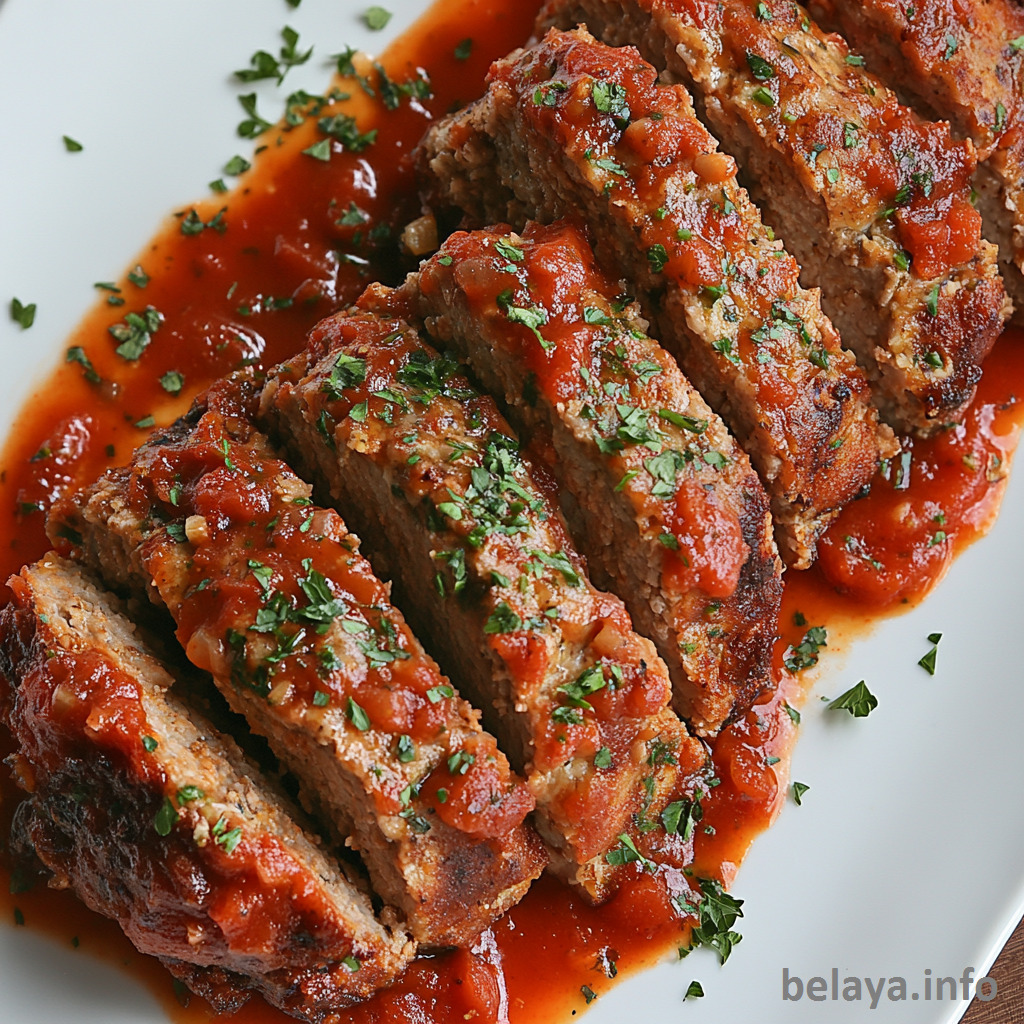
How to make Italian Meatloaf
Ingredients:
1 small onion, cut into 1-inch pieces
1 carrot, cut into 1-inch pieces
1 stalk celery, cut into 1-inch pieces
3 garlic cloves
2 tablespoons olive oil
2 large eggs
¼ cup finely chopped fresh basil
1 teaspoon salt
½ teaspoon freshly ground black pepper
1 tablespoon Worcestershire sauce
2 pounds meatloaf mix (or use 1½ pounds 85% lean ground beef plus ½ pound ground pork)
⅔ cup Italian-style bread crumbs
¾ cup grated Parmigiano-Reggiano
¾ cup marinara sauce, plus more for serving
Instructions:
Preheat and prep:
Preheat your oven to 350°F (175°C).
Position the oven rack in the center.
Line a baking sheet with aluminum foil and lightly coat it with nonstick spray.
Chop the vegetables:
Add the onion, carrot, celery, and garlic to a food processor and pulse until finely chopped. (No processor?
You can chop everything by hand.)
Sauté the veggie mix:
Heat olive oil in a medium skillet over medium heat.
Add the chopped vegetables and cook, stirring often, for about 5–7 minutes until they’re soft but not browned.
Set aside to cool slightly.
Mix the base:
In a large bowl, whisk together the eggs, chopped basil, salt, pepper, and Worcestershire sauce.
Combine the meatloaf mixture:
Add the ground meat, bread crumbs, grated cheese, and sautéed veggies to the egg mixture.
Use your hands to mix everything together until fully combined.
Shape the loaf:
On your prepared baking sheet, form the meat mixture into a loaf shape—about 9×5 inches.
Spread the marinara sauce over the top, letting it run slightly over the sides.
Bake:
Bake for 65–70 minutes, or until the center reaches 160°F (71°C) on an instant-read thermometer.
Remove from the oven and let it rest for 10 minutes.
Serve:
Carefully scrape away any excess fat around the edges.
Transfer the meatloaf to a serving plate or cutting board.
Slice and serve warm with extra marinara, if you like.
To freeze (before or after baking):
After baking: Let cool completely, wrap tightly, and freeze for up to 3 months. Thaw overnight in the fridge, then reheat in a 300°F oven.
Before baking: Wrap the shaped (but unbaked) meatloaf in plastic and foil. Freeze up to 2 months. Add sauce after thawing and bake as instructed.
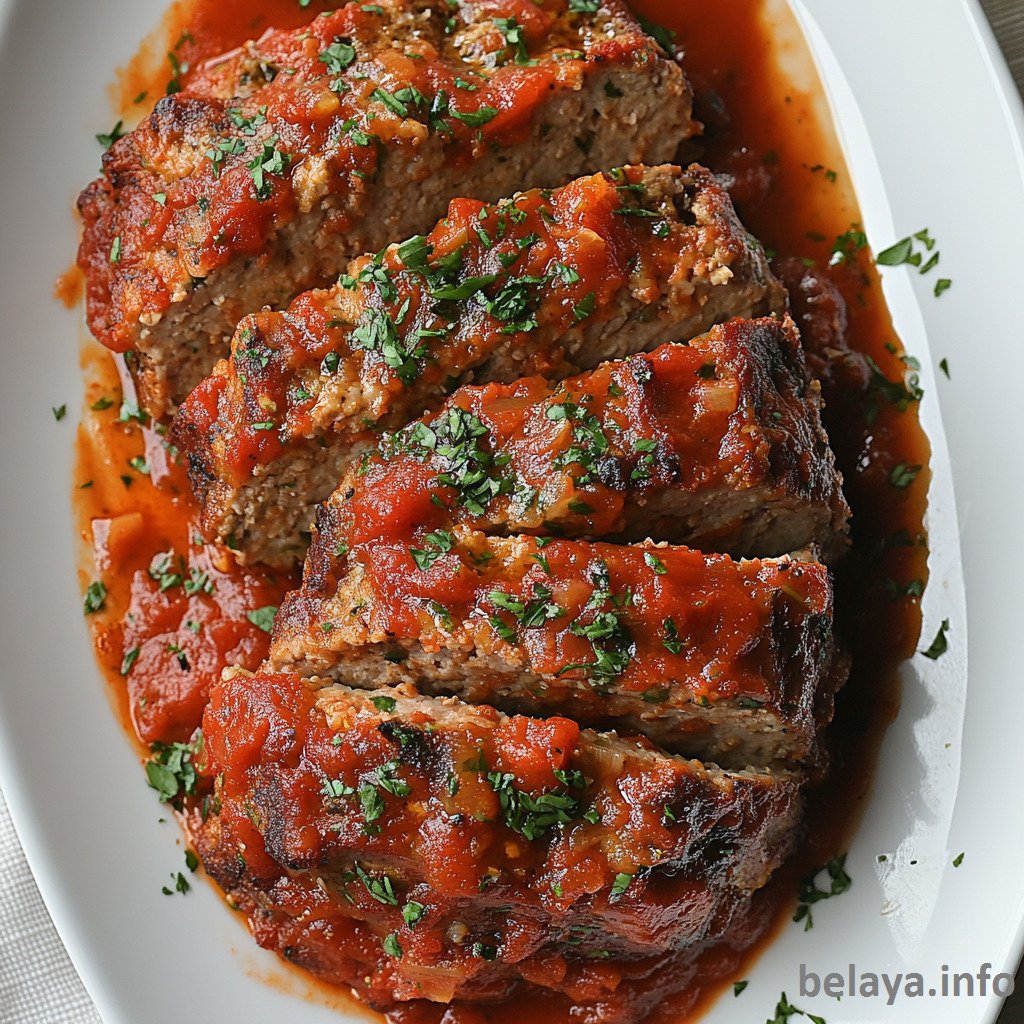
Important Notes
Balance of Meats Matters:
The combination of ground beef and pork isn’t arbitrary—it’s essential. Beef offers structure and bold flavor, while pork contributes fat and tenderness. Using all beef can result in a drier, less flavorful loaf. Aim for an 85/15 lean-to-fat ratio for ideal moisture.
Vegetables as Flavor, Not Filler:
The sautéed onion, carrot, celery, and garlic are not simply add-ins—they replicate a classic Italian soffritto and serve as the aromatic heart of the dish. These vegetables create a natural sweetness and complexity, binding with the meat and enhancing depth without overpowering.
Fresh Herbs vs. Dried:
Fresh basil isn’t just garnish—it’s critical for brightness and authenticity. Dried basil lacks the volatile oils that give fresh basil its signature perfume, which balances the richness of the meat and cheese.
Why Marinara on Top (Not Inside):
Adding sauce on top rather than within prevents the interior from becoming soggy. It allows the loaf to form a crust while the top remains moist and tangy. Extra marinara served on the side also lets each person control the sauciness.
Resting is Non-Negotiable:
Skipping the resting time after baking is one of the most common mistakes. Just like with roast meats, resting allows the juices to settle back into the loaf. Cutting it too soon leads to dry slices and flavor loss.
Texture Starts with Mixing:
The way you mix the ingredients affects the final product. Over-mixing compresses the meat proteins, resulting in a dense loaf. Use your hands gently and stop mixing once everything is evenly combined.
Cooked Veggies Must Cool:
It’s crucial to let the sautéed vegetables cool before mixing them with the raw meat and eggs. Hot ingredients can start cooking the meat or scramble the eggs prematurely, which affects both texture and appearance.
It’s a Make-Ahead Hero:
This meatloaf stores and freezes beautifully, and its flavor improves after a day as the ingredients meld together. This makes it a smart option for meal planning, potlucks, or prepping in advance for gatherings.
Don’t Skip the Parmigiano-Reggiano:
This cheese isn’t just for richness—it provides salt, umami, and a slightly nutty edge that no other cheese can replicate. It enhances every element of the loaf and adds a touch of authenticity that ties it back to its Italian roots.

How to Enjoy This Dish After Cooking
Let It Rest First:
Once out of the oven, allow the meatloaf to rest for 10 minutes. This step is crucial—it allows the juices to redistribute and ensures each slice stays moist and flavorful.
Slice with Care:
Use a sharp, serrated knife for clean cuts. Slice only what you plan to serve immediately to keep the rest juicy for later.
Serve with Extra Marinara:
Warm additional marinara sauce and spoon it generously over each slice. The acidity and richness of the tomato sauce beautifully complement the savory meat and cheese.
Pair It Thoughtfully:
Classic pairing: Serve with creamy mashed potatoes or garlic butter pasta.
Lighter option: A simple arugula salad with lemon vinaigrette balances the richness.
Rustic side: Roasted vegetables or sautéed greens like spinach or broccolini.
Turn Leftovers Into New Meals:
Meatloaf Sandwich: Layer slices on toasted ciabatta with fresh mozzarella and more marinara.
Meatloaf Parmigiana: Reheat slices with extra sauce and cheese, then broil until bubbly.
Pasta Topper: Crumble leftover meatloaf over spaghetti for a hearty, semi-homemade ragu.
Store Smartly:
Wrap leftover slices tightly in foil or store in an airtight container. Keep in the fridge for up to 4 days or freeze for up to 3 months.
Reheat Gently:
Warm in a 300°F oven, covered with foil, until heated through (about 15–20 minutes), or gently reheat slices in a covered skillet with marinara or a splash of broth to keep them moist.

Nutrition Information:
For 1 serving of the Italian Meatloaf recipe (based on approximately 8 servings total from the full loaf):
Calories: 355 kcal | Total Fat: 21.4 g | Saturated Fat: 7.5 g | Monounsaturated Fat: 9.1 g | Polyunsaturated Fat: 1.7 g | Cholesterol: 125 mg | Sodium: 530–620 mg (depending on salt and marinara brand) | Total Carbohydrates: 12.6 g | Dietary Fiber: 1.5 g | Sugars: 3.2 g | Protein: 27.8 g
Notes:
This estimate includes the beef/pork mixture, sautéed vegetables, eggs, bread crumbs, cheese, and marinara sauce (¾ cup in loaf + some on top).
It assumes moderate sodium marinara and does not include optional extra sauce served on the side.
Values can vary based on specific ingredient brands and ratios (e.g., cheese type, breadcrumb seasoning, or lean/fat ratio of meat).

Frequently Asked Questions:
Can I use all ground beef instead of a beef and pork mix?
Yes, you can use all ground beef, but the texture and flavor will be slightly different.
Pork adds moisture and a subtle sweetness, so if using only beef, choose one with at least 15% fat (85/15) to prevent the loaf from drying out.
You may also consider adding a tablespoon of milk or olive oil to maintain tenderness.
Can I prepare this meatloaf ahead of time?
Absolutely. You can fully assemble the meatloaf up to a day in advance, cover it tightly, and refrigerate it until you’re ready to bake.
Alternatively, you can freeze the unbaked loaf for up to 2 months.
When ready, thaw in the fridge, top with marinara, and bake as directed.
How do I know when the meatloaf is fully cooked?
The most accurate method is to use an instant-read thermometer inserted into the center of the loaf.
It’s done when it reaches 160°F (71°C).
Avoid relying solely on time, as ovens and loaf thicknesses vary.
Can I substitute dried herbs for fresh basil?
You can substitute dried basil, but use it sparingly—about 1 teaspoon in place of ¼ cup fresh.
Dried herbs are more concentrated but lack the bright, aromatic quality of fresh basil.
If possible, balance it with a touch of fresh parsley or a splash of lemon juice for brightness.
What’s the best way to reheat leftovers without drying them out?
Reheat slices in a 300°F (150°C) oven, covered loosely with foil, for about 15–20 minutes.
You can also warm them gently on the stovetop in a covered skillet with a few tablespoons of marinara or broth to keep moisture locked in.
How finely should I chop the vegetables before sautéing?
Aim for a fine mince, similar to the consistency of rice grains.
This ensures the vegetables blend seamlessly into the meat mixture, enhancing flavor without creating chunks.
Using a food processor makes this quicker and more uniform, but careful hand-chopping works just as well.
Why do I need to cook the vegetables before mixing them into the meat?
Cooking the vegetables softens their texture and mellows their raw flavor, especially the onions and garlic.
It also releases moisture, preventing excess liquid from seeping into the meatloaf as it bakes, which could make it soggy or crumbly.
What’s the best technique for shaping the loaf?
Shape the loaf gently with your hands into a 9×5-inch oval or rectangular form directly on a foil-lined baking sheet.
Avoid compacting the mixture too tightly—overpacking leads to a dense texture.
A light touch helps keep the interior tender and airy.
Should I use a loaf pan or bake it free-form?
Free-form on a baking sheet is preferred for this recipe. It allows better air circulation and creates a flavorful crust on the outside.
A loaf pan can trap steam, leading to a more steamed texture and less browning.
Can I add cheese inside the meatloaf for a gooey center?
Yes! For a fun twist, add a layer of mozzarella or provolone down the center when shaping the loaf. Just be sure to seal the edges well to keep the cheese from leaking out during baking.
This creates a melty, surprise-filled center that adds richness and wow-factor.